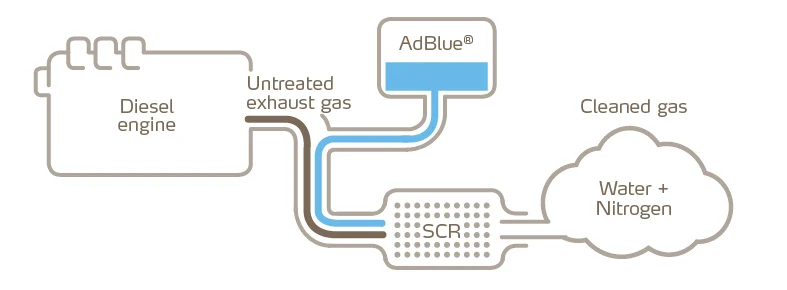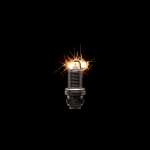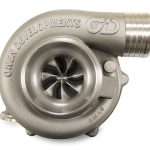Many modern diesel vehicles use AdBlue to meet emission standards. This applies not only to trucks, heavy commercial vehicles, ships, and tractors but also to different types of passenger cars. But what is AdBlue and how does it work? In this article, we will elaborate on this in more detail.

What is it?
AdBlue is a clear mixture of demineralized water and pure urea (32.5%) and is also referred to as Diesel Exhaust Fluid or AUS 32. It is designed to reduce harmful emissions of nitrogen oxides (NOx) from diesel vehicles to non-hazardous gases, in order to comply with more stringent emission standards.
When is it used?
AdBlue is used in vehicles with a Selective Catalytic Reduction catalyst or SCR. An SCR catalyst ensures that exhaust gases are treated before they leave the vehicle. A large proportion of the heavy-duty vehicles complying with the Euro 4, Euro 5, and Euro 6 standards are equipped with an SCR system and therefore use AdBlue. This applies to most trucks after 2005; the first passenger cars with diesel engines and SCR were introduced in response to the Euro 6 standard in 2014.
An SCR is located behind the particulate filter in the exhaust. When a certain amount of NOx wants to enter the catalyst, a measured dose of the fluid is injected from the AdBlue reservoir. the fluid is converted by the SCR catalyst into ammonia and a small amount of carbon dioxide. The formed ammonia reacts with the NOx, creating the non-hazardous substances nitrogen and water. The SCR catalyst ensures that this reaction takes place quickly and sufficiently.
Adding AdBlue
When driving a vehicle using AdBlue, you will get a message on the dashboard if the fluid needs to be topped up. You can do this yourself or have it done in your garage. It is important to follow up on this message as soon as possible; a too-low AdBlue level may prevent your vehicle from starting.
The location of the fluid reservoir varies. For passenger cars, it is usually located next to the diesel filling aperture, recognizable by the blue cap. Sometimes, however, the AdBlue tank is located in a different place. Consult your vehicle’s manual if necessary. For trucks, it is often possible to refill AdBlue at the larger filling stations, for passenger cars and vans small package sizes are available. However, it is important that the AdBlue is not refilled until you receive a refill notification. If the reservoir is refilled earlier and thus becomes too full, the liquid crystallizes at the filling neck, which can deform as a result. If AdBlue is spilled, it is advisable to remove the liquid with a sponge and warm water.
What happens if I don’t use it?
If an SCR-equipped vehicle runs out of AdBlue, it will fail to start.
But don’t worry, because a warning message will appear on the dashboard, alerting you that the level of the fluid is running low.
In the case of Volkswagen, the first message appears when the remaining range is 1,500 miles and is repeated every 62 miles until the range reaches 1,000 miles.
At this point, the message turns amber and is repeated every 31 miles.
Eventually, the warning turns red, before the car will not restart and the ignition is turned off.
Does every diesel need it?
the fluid should only be used in diesel cars fitted with an SCR system, so if in doubt, consult the vehicle handbook.
As a rule of thumb, the more recently the diesel car was built, the more likely it is to use the fluid, as the Euro 6 regulations were introduced in 2014. Find out your car’s Euro emissions rating here.
For example, SCR technology is fitted to all Land Rover diesel vehicles built from the 2016 model year, while Jaguar, Audi, Citroen, Peugeot, Mercedes-Benz, SEAT, Skoda, and Volkswagen all use the fluid tech.
Can I refill the AdBlue myself?
Not every car allows you to refill the fluid tank yourself, but you can easily find out if yours does. Behind the fuel filler flap, there’ll be an extra filler with a blue cap for the AdBlue, next to the regular diesel filler. The tank itself is underneath the car, next to the fuel tank.
AdBlue is available from most fuel stations and car parts shops. It comes in containers of up to 10 liters, which typically cost between £15 and £20. The container will come with a nozzle to make pouring the AdBlue into the filler much easier. Alternatively, fuel station HGV lanes have AdBlue pumps that you can use to fill your car if it has a suitable nozzle.
It’s absolutely vital that you don’t accidentally pour AdBlue into your car’s fuel tank. If you do, the tank will need draining and flushing cleaning. Fortunately, you can’t put diesel in the AdBlue tank by accident because the pump nozzle is far too big.
If your car doesn’t have a dedicated AdBlue filler, the tank can only be refilled by a garage (because the filler is usually hidden below the boot). The tank should be topped up every time your car is serviced, so make sure the garage doing the work includes it. If the tank needs refilling between services, most garages will do so for a small charge.
For More Press Here









